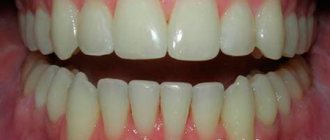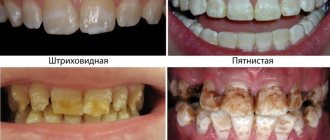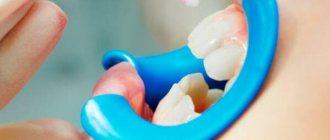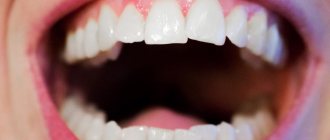Why do my child's teeth grow unevenly?
How straight your child’s teeth will be when he grows up depends on the developing bite and pathologies of individual teeth. The answer to the question “what bite is considered correct?” you hardly have any doubts - the one in which the upper jaw overlaps the lower jaw. However, normally, all children are born with progeny: their lower jaw is slightly pushed forward so that it is convenient to grasp the breast with their mouth when feeding. Over time, the lower jaw returns to its place, after which the process of bite formation begins - first the milk bite (up to 6 years), then the replacement (up to 11 years) and permanent (up to 15 years). How correct it will be depends on several factors:
- Heredity.
Uneven teeth in a child may be the result of heredity. If one of the parents has an incorrect bite or a wide gap between the front teeth, this can be passed on to the children at the genetic level.
- Congenital pathologies.
Insufficient amniotic fluid, viral infections and/or mechanical injuries during pregnancy and childbirth can all later cause abnormal jaw development and the appearance of uneven teeth in the child.
- Nutritional features.
If a child's diet does not contain enough natural solid foods (such as raw vegetables and fruits), his jaws do not receive the necessary chewing load. As a result, the risk of developing a malocclusion increases.
- Chronic diseases of the nasopharynx.
They make nasal breathing difficult, and the child is forced to breathe through the mouth. This negatively affects the formation of the bite.
- Bad habits.
For example, prolonged pacifier sucking, one-sided chewing, the habit of biting nails or holding foreign objects in the mouth can lead to bite problems in adulthood.
Half a year is not mandatory
It happens that babies delight their parents with their teeth already in the 4th month. Parents never consider such a “deviation” from the norm as something negative.
True, sometimes premature appearance can be provoked, for example, by endocrine disorders. But, if the child’s teeth are delayed, and the baby does not have them at 7, 8, 9 or even 12 months, then the parents begin to panic.
The experience of doctors says that there may be no teeth even at 1.5 years old, and even this situation is not a reason for panic and unnecessary concern for the child’s health. A particular baby has his own pace.
Are uneven baby teeth a problem?
When a baby's first teeth begin to grow, they are usually straight and close together. As the child grows, his jaw also increases in size, causing the teeth to “diverge.” Normally, the spaces between the teeth should be even. If the first teeth are uneven and unequally spaced, this may indicate that the jaw is developing asymmetrically. Does your child have uneven baby teeth? Don't think that they will become smoother with age. Instead, take your child to the pediatric dentist. Timely diagnosis and treatment will help avoid serious consequences, such as the appearance of uneven molars.
A little about the norms
In what cases is it worth contacting a dentist, and when the natural process of teething is simply delayed? We can talk about pathology if:
- Your child is already a year old, but he does not have a single incisor.
- By the age of 3, the set should consist of 20 teeth, including canines, molars, and premolars.
- At 6-8 years old, not a single incisor fell out. It is possible that some components of the bite will not change at all, but it is better to clarify this issue with your dentist.
- The loss of primary incisors occurred more than 3 months ago, and the future change is not even visible in the gums.
- The gums have become very red or darkened and remain that way for a long time. Perhaps the future tooth cannot cut a “path” for itself, blood has thickened in the hollow or a slight inflammation has begun. The problem is eliminated by micro-operation - dissection of the gums. Within 2-3 weeks after it you will see a white molar.
- The erupted tooth has a clear defect - this is due to caries damage to the milk tooth, and then to the rudiment of the molar. Therefore, timely treatment of temporary children’s teeth is important.
- 2 primary incisors fell out, and in their place one large tooth grew - in this case, we can talk about a serious violation of the future occlusion. In this case, the child needs to consult an orthodontist, who will prescribe wearing plates or braces.
If one of the symptoms matches, it’s time to visit the dentist. Do not forget also about planned visits, which must be made at least once a year. This is not only the prevention of caries, pulpitis and a number of other diseases, but also control over the proper development of the jaws.
If your child's permanent teeth grow unevenly
Often, even a correct bite and straight baby teeth are not a guarantee that a child’s uneven molars will not “come out.” Most permanent teeth erupt unevenly (and this is normal), but as they “come out” they unfold. As the child's jaw grows, there is more room for new teeth, so they gradually take on the correct position. But it also happens that the jaw increases in size much more slowly than the teeth. As a result, the latter do not have enough free space, which is why they continue to grow unevenly or begin to “crawl” on top of each other, and sometimes even line up in two rows. A similar situation is also possible if a child has a baby tooth removed ahead of time.
A baby tooth falls out and a new one doesn’t grow – why?
Sometimes the development of permanent teeth is hindered by the following reasons:
- If the baby has suffered an infectious disease. The emergence of health problems means a lot of stress and energy consumption. A set of resources necessary for the construction and provision of minerals to a molar. He is left to fight the disease. It is common for experienced pediatricians to warn about this. They prescribe vitamins for preventive purposes.
- Not enough calcium. The cause of such deficiency is not necessarily associated with pathological changes and diseases. There are cases of congenital manifestation, especially when the child is born prematurely. Poor nutrition may also be a cause. Because of this, the baby’s hair grows poorly, the skin turns pale, the nails become soft and brittle, and it is necessary to urgently adjust the diet. Among the existing tips that traditional medicine gives is the use of eggshell powder. However, you must first consult with a nutritionist.
- Due to caries, the base of an old tooth or a future permanent one can be affected. Then tooth growth will be delayed. Or the tooth will grow in the wrong direction. Vigilance is important so that malocclusion does not develop and it is clear how long it will take for the tooth to grow after the milk one.
- Mechanical injuries due to a fall and a strong blow to the jaw. Then the surface of the buds can be “driven” into the gum and periosteum. Only surgical intervention can correct the situation. The health of the tooth depends on the speed of its use if baby teeth have fallen out and permanent teeth do not grow.
Devices for correcting uneven teeth
Braces
Most often they are installed on children over 12 years of age. These structures are non-removable and are made of different materials (metal, ceramics and others). They are securely attached to the teeth and, by exerting constant pressure on the teeth, over time they change the bite, correct crowding, and also eliminate large gaps between the teeth. Typically, treatment with braces takes from six months to two years (depending on the complexity of the clinical case).
Aligners
These are modern analogues of braces that can be used to straighten teeth from 16 to 18 years of age. They are translucent, almost invisible aligner trays on the teeth that must be worn around the clock, removing them only for eating and brushing teeth. Over 14 to 30 days, the teeth shift to a certain position, after which the aligners are replaced with the next pair. The treatment period is the same as in the case of braces.
Trainers, removable plates, lip bumpers
These devices are used to correct malocclusion and uneven teeth in children from 4 to 6 years of age. They should be worn for a certain number of hours or only worn at night. This treatment is very effective when the jaws are in the growth stage.
Attention!
Any orthodontic treatment requires consolidation of the result. To prevent straight teeth from assuming the wrong position again, for example, after straightening with braces, doctors recommend using retainers.
Why don't they grow permanently right away?
An adult needs 32 pieces for nutrition. So many teeth cannot fit on a child’s small jaw, so there are only 20 of them. A baby’s mouth cannot accommodate the number that is needed at an older age. The child grows, and the jaws grow with him, becoming the same size as in infancy. For this reason, their appearance is sloppy, and often there are gaps between them.
Under the layer of the first row, permanent teeth begin to form, which break through at the age of 6-7 years. They replace the milk ones, and they begin to fall out because they are no longer needed. Surprisingly, permanent teeth begin to form earlier than you might think. This process begins immediately after the birth of the baby under the not yet erupted.
Why do we need baby teeth? For humans, it is important to form the facial skeleton without pathological changes. The growth of a child’s bones occurs due to a series of loads that are carried out gradually.
And the facial bones grow in the same way. It is they, with the unique structure of the root system, that contribute to the correct development of bones in the right direction. Probably though. The main task is to show the roots where to go in growth. These are the pioneers who make their way into the gums and then make room for the permanent ones.
If a baby tooth falls out and a new one does not grow, you should consult a dentist.
Tips for parents on prevention
1. Wean your child off pacifiers in a timely manner (from about 8 to 9 months, since it is during this period that the baby develops a chewing reflex and the need for sucking decreases) or replace them with anatomically shaped vestibular plates.
2. Fight your child’s bad habits. Wean him off, for example, thumb sucking or nail biting.
3. Monitor your child’s diet, including more solid fresh vegetables and fruits in his diet - carrots, apples, pears, cucumbers and the like.
4. Monitor the health of teeth (including milk teeth) and gums by forcing your child to maintain oral hygiene. Visit the dentist with your child at least twice a year: treat caries and other dental diseases and try to prevent the loss of baby teeth too early - this can lead to displacement of the entire dentition. If premature removal of a baby tooth is unavoidable, doctors advise replacing it with a removable denture.
Main reasons
Baby teeth are destined to grow in a special order. Thus, their replacement does not occur immediately. The process takes some time. Please note that replacing baby teeth with permanent teeth does not necessarily happen in an exact sequence. The loss of milk will certainly lead to the formation of a new one. At first only a small part of it appears, and later it occupies the entire allocated area.
One week passes, then another, but there are no new growths. Is this pathology? Don't worry prematurely. You should know that natives need more time to grow. There are cases where a new tooth appeared after one or two months.
In fact, there are quite a lot of reasons. Even in some adults, dentists discover baby teeth. This is easy to do, since the latter have a different shape.
To dispel all doubts, you must immediately take a picture of the jaw. The rudiments of permanent teeth will be visible on it. Worried that they will grow crookedly or even behind the main ones? In this case, it is necessary to put braces on the children. You can be sure that this deficiency will be completely eliminated.
As for the reasons, the main one is the absence of rudiments in the hole. This process is irreversible, because they are formed only during the intrauterine development of the fetus. This can be corrected by implantation. It is carried out at the age of 18, when the formation of the jaw bones ends. Only the eighth teeth are laid in adulthood. Their rudiments are observed around the age of fourteen.
You should consult a doctor in the following situations:
- More than 3 months have passed since the baby tooth fell out, and new ones have not appeared.
- The gums become very swollen and red. By the way, she even turns black. This means that the tooth does not erupt, and a lot of blood has accumulated in the gum. The steps are simple: the surgeon opens the problem area, thereby allowing blood to flow out.
Postponed rickets can be the main reason for the absence of indigenous formations. Complex infections, as well as jaw injuries, are the main causes. It is imperative to take these parameters into account and inform your attending physician about them.
Read also: What time do baby teeth change in children?
R
Let's look at the main reasons for delayed growth of molars:
- Lack of minerals in the body. For example, if there is little calcium, then there is nothing surprising in the delay. Make sure your child eats properly.
- It is worth saying that caries from a baby tooth is transferred to a permanent one. As a result, not only does the growth of the latter slow down, but it also appears with a defect.
- Trauma to the jaw affects the location of the tooth germ. You should definitely take the necessary photo. It is imperative to correct the deficiency in time, otherwise the new teeth will be crooked. Surgery cannot be avoided.
- Ecological deterioration. Negative environmental factors have a strong influence on the child.
- Constant consumption of unhealthy foods.
- Frequent stress. This phenomenon should be avoided as much as possible.
- Low load on the jaw. This factor is considered common. Pates and purees are not the best diet during this period, but crackers and apples are what you need!
Some facts about teething in humans
Teething is a dynamic and complex physiological process that continues for several years. At this time, the maturation of tooth germs or follicles occurs and their migration inside the jaw until they finally erupt into the oral cavity and take their proper functional position in the dentition.
Teething is often quite painful
Teething involves a gradual transition from one bite to another: a temporary or milk bite is replaced by a permanent one. This process is very closely related to the child’s bone development, in particular, to the correct growth of the skull bones. In this case, there is a parallel formation of bone structures, soft tissues surrounding the tooth, and resorption of the roots of baby teeth to make room for permanent teeth. The rate of eruption depends on the timing of completion of the formation of dental follicles on both sides of the dental arch.
Child with a gum massager toy
The first stages of dental development begin in the embryonic stage, this process ends with the eruption of third molars (wisdom teeth) at the age of 20 years. The direct mechanism of eruption has not yet been fully studied; scientists have put forward some guesses, but none of them have been proven in practice.
The structure of a wisdom tooth is no different from other teeth, or more precisely, from other molars, that is, teeth that perform a chewing function.
When teeth appear
At what months do babies start teething? When do the first symptoms of tooth growth appear, and what should a mother do in this case?
- The first milk teeth are cut at the age of 5-7 months. These should be the two lower central teeth.
- The first upper incisors appear when the baby reaches the age of 8-12 months.
- The first lateral incisors appear at the top by 10-13 months of life.
- The lower lateral incisors grow at 10-16 months.
- Fangs are cut from 17 to 22 months.
- A child’s first molars (chewing teeth) appear at one or one and a half years, while the second molars are cut at 25-33 months.
In accordance with this scheme, a child should have from four (minimum) to twelve teeth by the age of one year. Why is there such a difference in the number of teeth in different babies? Because everyone’s teeth grow differently, and it depends on many factors.
Important!
If a child has not grown a single tooth by the age of one year, show him to the pediatric dentist.
Why do teeth grow slowly?
If a child has received a birth injury, there is a possibility of delayed teething, because in their infancy they receive insufficient amounts of arterial blood, and calcium deficiency occurs.
After teething, such teeth are more likely to suffer from caries and may be unevenly positioned. Painful teething is an alarming symptom. In the presence of a birth injury, tooth growth may be accompanied by an increase in temperature and fever. This is because the tissue around the tooth swells, but because the jaws are misaligned, it causes serious discomfort.
Bowel problems are another symptom of birth trauma. This is due to compression of the jugular foramen, which leads to food being poorly digested and nutrients being poorly absorbed.
The conclusion is that if teeth erupt slowly, the child should be shown to an osteopath. Recovering from birth trauma will relieve the baby of pain and digestive problems, and reduce the risk of dental caries.
What determines the timing of teeth appearance?
The age of formation of primary and permanent teeth in children has relative variations that can be correlated with certain phenomena.
- Floor. All teeth, except the upper first chewing one, erupt earlier in girls than in boys.
- Height.
The literature reports a special relationship between the child’s body length and the time of teething. On average, short children develop teeth a little later. Baby is cutting teeth - Jaws. Teeth eruption occurs faster in the lower jaw than in the upper jaw.
- Position of teeth. The last teeth in each group (third molars, second premolars) are more likely to experience delayed eruption.
- Bite.
In temporary dentition, delayed eruption occurs much less frequently than in permanent dentition. Milk bite - Population. Different dates for the appearance of teeth in people living in different countries have been identified. For example, among Europeans, delayed eruption is a relatively common occurrence.
- Climate. In warm climates, children's teeth erupt faster than in cold climates.
- Socio-economic conditions.
Children raised in poor conditions are more likely to suffer from delayed teething. Dysfunctional family - Level of urbanization. In urban conditions, children's teeth develop faster than in rural areas.
- Phylogenetic evolution. The modern population of people more often has problems with the eruption of wisdom teeth and canines in the upper jaw. Researchers attribute this phenomenon to the evolution of humans as a species and the lack of space on the jaw due to a decrease in its overall size.
- Birth order of the child. Children born later than their siblings are more likely to have delayed teething.
Why does a child have no teeth?
Why don't teeth grow?
Infants should have their first teeth before the age of one year. Everyone cuts them at their own time; there is no exact schedule for the appearance of teeth. It’s worse when the child’s incisors don’t grow at all. Why is this happening?
The reasons for missing teeth can be:
- genetic characteristics;
- climatic features;
- quality of food and water;
- illnesses in a child.
As a rule, teeth do not grow in children with rickets and edentia. Rickets appears in infants due to a lack of vitamin D. The disease is accompanied by changes in the structure of bone tissue; accordingly, molars and baby teeth will not be able to grow under such conditions.
Symptoms of rickets:
- baldness of the occipital part of the head;
- increased nervous excitability;
- disturbed sleep and appetite.
Adentia is the absence of tooth buds. The formation of future teeth occurs in the first weeks of pregnancy, when the expectant mother does not even know about it. Only a doctor can check the symptoms of such a deviation using a radiovisiograph or x-ray.
Violation of the period of tooth change
A less noticeable, but no less important period in a child’s life is the replacement of his milk teeth with molars. Many people probably have a question about why molars cannot grow right away. But this is how nature works, and at a certain age teeth change. Moreover, this age is purely individual. For some, this change happens quite quickly, but for others it drags on. And it is precisely the protracted process that becomes a problem when it is completely unclear why the root causes.
Here it is worth paying attention to the general development of the body: after all, teething depends on this. Also, the timing of the appearance of molars can be influenced by various past diseases. In any case, if you are faced with such a problem, it must be solved in the dentist’s office, who can conduct an examination and give the correct conclusion.
A thorough examination, which is intended to answer the question of why teeth do not grow, begins with x-ray diagnostics. This procedure helps determine the presence of permanent tooth buds in the child's jaw. This will also give you an approximate date for when teeth should start to emerge.
The most important thing in a situation where it is not clear why exactly your child’s molars are not yet growing is not to panic. Remember that today the environment and the general health of all people are changing quite dynamically. Those boundaries of periods of physical development of children that were relevant 10 years ago no longer have any meaning today.
The appearance of a child’s first teeth is another test of a young mother’s strength and endurance. What are the signs of teething in a baby? How can you help your baby when he is teething?
Teething occurs differently in infants. Some babies tolerate this calmly, and the mother simply states the fact that a new tooth has appeared. For other babies this event brings a lot of suffering:
- vomiting and diarrhea;
- temperature increase;
- tearfulness and restless sleep;
- allergic skin rashes;
- cough and sniffles.
How can you tell if your baby is just getting his first teeth and not some kind of infectious disease? Children at this age cannot explain anything, and most mothers simply panic. Before you panic, examine your baby's gums and check for teething symptoms:
- the gums will become swollen and red;
- increased salivation will appear;
- the baby will bite and gnaw everything;
- possible loss of appetite;
- the emotional state will be excited.
Teething in infants can be painless. If a child develops a fever and diarrhea begins, calling a doctor is mandatory.
Changes in the body caused by the growth of dental tissue are difficult for children with weakened immune systems to tolerate.









